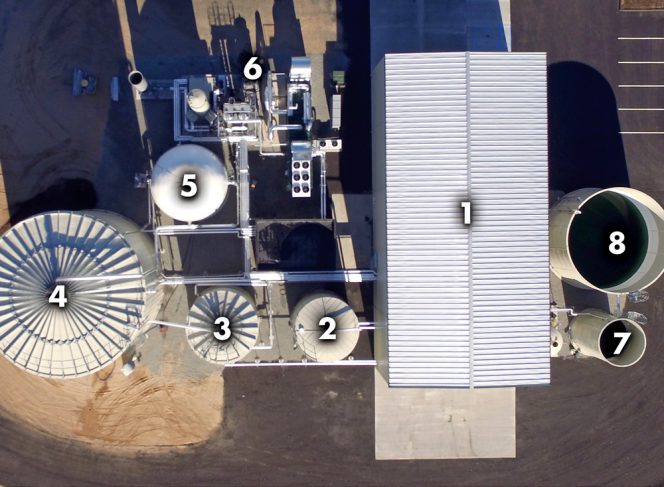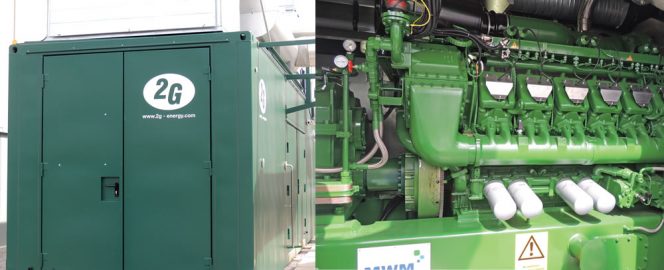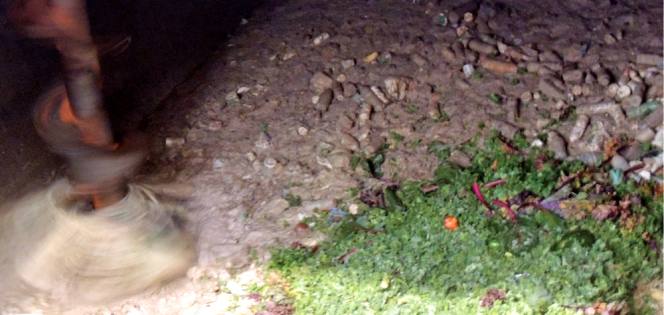Connecticut anaerobic digester has capacity to process 40,000 tons/year of dry and liquid food waste. The host community is purchasing the renewable power.
Bob Spencer, Morgan Casella and Nora Goldstein
BioCycle July 2017

Facility layout: (1) Receiving building, reception pit and food waste preprocessing; (2) Retention/hydrolysis tank; (3) Acetogenesis tank; (4) Primary digester; (5) Digestate holding tank; (6) Biogas conditioning and CHP skid; Effluent polishing with (7) nitrogen removal and (8) aeration prior to discharge.
“Our company has always looked at beneficial reuse opportunities for the materials we handle, and with the food waste ban on the books since July 2011 in Connecticut we decided to investigate anaerobic digestion,” explains Brian Paganini, Quantum Biopower’s Vice President/Managing Director. During a site visit in May 2017, Paganini and John Ferguson, Business Development Director, walked the authors through the $14 million facility. The plant started up in early 2017.
Merchant Plant
As a privately financed “merchant” plant, the owners knowingly took a risk to permit, finance and construct the facility with the expectation that the regulatory ban on disposal of food waste will drive generators to utilize such facilities. Paganini notes that an extended start-up process was anticipated and budgeted for, and is confident the company will soon have sufficient revenue from both tipping fees, and electricity generation, to cover the capital and operating costs.
Approximately three-quarters of the 40,000 tons/year of processing capacity are being utilized, and Quantum is working with industrial and commercial food generators to provide material to the plant. Current clients include supermarkets, a distillery, food distributors, food manufacturers, municipalities, universities, and many others. Components of the facility were designed to enable expansion to 80,000 tons/year by installing a second 1,000,000-gallon primary digester tank.
Given that another merchant AD facility is also under development in Southington, there will be competition for organics in this region of Connecticut. Ferguson acknowledges the challenge of inking long-term contracts for food waste in an evolving food diversion industry. “We are working with places like Yale University, Dunkin Donuts, Whole Foods, and many others, to help them achieve their sustainability and food diversion goals,” he says.
Revenue for the facility will come from a combination of tip fees, and sale of electricity, compost, fertilizer products, and the renewable energy credits (RECs) generated from the renewable biogas. “Our tip fees are about 20 percent below the prevailing landfill rates of $60 to $70/ton,” notes Paganini. Quantum plans to seek organic certification for its fertilizer and compost products, which is expected to provide additional revenues.
Quantum received a low interest loan from the Connecticut Green Bank to assist with permitting and development costs. The AD facility has four full-time employees, and generated about 50 full-time construction jobs. Quantum is working with the University of Connecticut on compost and digestate mixes, and a chemistry student intern from Southern Connecticut University was recently hired to run the on-site laboratory where digester health, feedstocks, digestate and wastewater discharge are tested.
“We have achieved all of our process milestones up to this point and are slightly ahead of schedule,” says Paganini. “The biology and process dictate how quickly the facility can ramp up. Quantum expects, by July, to produce a sufficient quantity of biogas with quality methane content to power the 1.2 megawatt MWM biogas combined heat and power (CHP) generator in order to sell electricity to the Town of Southington for $0.105 kWh under a 20-year power purchase agreement.” On the day of the tour, the meter measuring the concentration of methane in the biogas was at 70 percent concentration, indicating the blend of feedstocks, in terms of biomethane potential, were meeting the design parameters of the facility. The methane has been burned in a flare prior to CHP commissioning.
The challenges of developing and permitting a “first-of” anaerobic digestion facility in the state were detailed and numerous. When the project was conceived in 2013, there was no mechanism in Connecticut for a facility such as Quantum’s to sell Class 1 renewable electricity, outside of the traditional renewable energy procurement rounds. Quantum worked to support legislation that allowed Southington, its host community, to be the beneficial off taker of the power produced. In 2015, Connecticut became the 13th state in the country to successfully pass a Virtual Net Metering program, defining Quantum’s power off-take future with Southington.
It took Quantum roughly two years to obtain its critical permits from the Connecticut Department of Energy and Environmental Protection (CT DEEP). “We asked a lot of our local and state regulatory agencies to permit a solid waste facility, multiple emission sources, and wastewater discharges,” says Paganini. “There was certainly an educational component, among all parties involved, to understand this unique technology, and how the current state regulations could be applied. In some instances, the technology has outpaced the regulations, so there was a learning curve on both sides.”
Technology Selection
Initially, Quantum was seeking a solution that could repurpose forest by-product materials, and investigated wood gasification and pyrolysis. It determined that the technology was still not ready for commercialization. The company then turned from thermo-chemical designs to biological processes like anaerobic digestion.
Quantum evaluated AD technology vendors in the U.S. and worldwide. Of the 25 off-the-shelf digester systems, 12 were assessed in detail. Technology selection criteria were developed based on the needs of the flagship project, such as cost, biogas production, footprint, and process guarantees. Quantum traveled to Europe to tour high solids fermentation, wet reaction processes, and hybrids.
In Quantum’s diligence phase, they had considered high solids AD, which allows for green waste (yard/leaf/biomass cuttings) to be digested along with food waste and some soiled paper materials. However, in order to maximize biogas potential, Quantum learned that green waste must be digested within 72 hours of initial cutting. This, coupled with Quantum’s desire to maximize biogas production, pushed the company to seek a wet fermentation process. In addition, high solids AD requires a larger footprint per volume of feedstock material, Quantum concluded that the capital expense of the vessels was significantly higher than liquid-based systems.
Once it decided to pursue a liquid, or low solids AD technology, the next challenge was meeting Connecticut’s wastewater discharge permit standards. Connecticut does not have a food waste and biosolids codigestion standard since it does not permit land application of biosolids. Therefore, biosolids, which can be an excellent revenue source and substrate for liquid AD, was not an option, and limited the investigation to food waste only AD systems.
After a year of investigation, Quantum selected Global Water Engineering (GWE), a group of companies based in Belgium that specialize in industrial wastewater treatment, water recycling, biomass digestion, and biogas production and use. GWE has more than 300 operating plants in more than 70 countries worldwide. For the Quantum facility in Connecticut, GWE provided the design and licensed Quantum to utilize and market the technology. The license comes with guarantees of phosphorus and nitrogen removal limits for digestate discharge to the Southington municipal wastewater system.
The GWE system has a 1 million gallon primary AD tank, fed through a staged series of tanks that introduce feedstock to the system. Photo on page 33 shows the Quantum facility layout. Quantum had a team of skilled professionals to construct the project over a 10 month period.
Food Waste Preprocessing
To maximize the range of food waste it could process, Quantum wanted the ability to accept most dry and liquid food wastes, and various types of packaging. Thus it needed a robust food waste decontamination step to accomplish this goal. The company analyzed the depackaging and preprocessing equipment available in the U.S. and Europe and started working with DODA on designs for front-end preprocessing/depackaging.
Quantum ultimately chose a DODA wet system separator and installed the equipment, along with a receiving tank and agitation system, in the reception building. Paganini describes the separation process as the key element of the Southington facility’s design. “We wanted a homogenous AD feedstock while being able to accept almost any food waste material,” he explains.
The reception building has a high speed automatic door where trucks pull in and the door closes. Food waste is unloaded into a 20-foot by 15-foot pit that is 12-feet deep. If packaged food is contained in large cardboard boxes, the cardboard may be separated for recycling. However, the entire box can be tipped into the pit for processing. Quantum accepts compostable plastic bags since they disintegrate in the AD process, as do paper products.
Paganini has also observed that some of the source separated organics (SSO) loads it receives from New York City contain fiber lunch trays, which make their way into the digesters and are consumed by the microbial process. However, compostable cutlery does not break down as evidenced in the rejected materials. “We estimate that on average, about 10 percent of the total volume of SSO is reject material and we are evaluating if this is mostly plastic material that can be incinerated,” explains Paganini. (A large percentage of Connecticut’s MSW is managed at waste-to-energy facilities in the state.)
Approximately 10 air changes per hour keep the reception area under negative pressure, with the exhaust treated in a carbon filter. Material is diluted to the proper viscosity (packaged food waste included) before being pulled into the DODA vertical separator. The feedstock pit is designed to be part of the process, and can hold 140 tons/day of food waste, plus the corresponding liquid dilution volume to get the material to 6 to 7 percent total suspended solids. Potable water is primarily used in the reception pit, although Quantum Biopower, per its wastewater discharge permit, can recycle up to 30 percent of its digested effluent as dilution water to reach the target of 6 to 7 percent solids in the reception pit. The balance of the wastewater is discharged to the sewer after nutrient removal/recovery.

The 1.2 megawatt combined heat and power generator (right) is integrated with related components and housed in a container (left) supplied by 2G Energy.
Digestion Phase
From the separator in the reception building, liquid food waste is pumped into a 50,000-gallon retention/hydrolysis tank, where 420 tons of liquefied food waste (3 days worth of food waste feedstock) can be stored and begin to break down. Paganini describes this tank as the “fat spot” in the system, allowing for back-up receiving capacity.
The liquid feedstock is then dosed into a 70,000-gallon acetogenesis tank for 3 days retention before being pumped into the primary 1 million-gallon AD tank for an 18-day retention time. Both tanks operate at thermophilic temperatures that average 135°F. Besides meeting the process to further reduce pathogens (PFRP) requirement in the first two tanks (hydrolysis and acetogenesis, the higher temperatures of thermophilic AD are also more effective at breaking down fats, oils and grease, notes Paganini, who estimates that the volume reduction on solids is about 70 percent. The facility also utilizes a final digestate holding tank before the material goes through separation and the effluent is treated before discharge.
Biogas is collected from the acetogenesis tank and the primary tank, as well as from another small tank that holds liquid digestate. It is conditioned by dual membrane biological scrubbing to remove hydrogen sulfide (H2S). GWE and Quantum selected the 1.2 MW MWM CHP generator. It was integrated with related components by 2G Energy, which designed the scrubbing and stripping of biogas to MWM’s warranty specifications; 2G also guarantees emissions compliance off the primary CHP emissions stack. The system has an estimated 15 percent parasitic load for operations, or 180 kW. Heat produced from the CHP is available to maintain tank temperatures, making Quantum’s system self-sustaining from a tank heating perspective.
The AD tanks are mixed with externally mounted hydraulic mixing pumps that are enclosed in an adjacent building to provide easier access for maintenance. The pump house was included in order to have all exterior heat exchange and pump equipment housed in an environmentally controlled, accessible room. The initial retention/hydrolysis tank has an external, large surface area heat exchanger that repurposes CHP heat to bring the incoming liquid food waste up to thermophilic temperatures. In addition to the hydraulic mixing pumps there are mechanical mixers inside digester tanks in order to minimize differential temperature zones in the tank.
The final polishing steps — before discharging the treated effluent to the sewer system — include a Struvite process to remove phosphorous from digestate, and dewatering via a centrifuge to separate solids. In accordance with Quantum’s Miscellaneous General Discharge Permit from Connecticut DEEP, nitrogen is removed in a small tank, and the liquid is aerated prior to discharge to the sewer.
Quantum projects that once it is processing 40,000 tons/year of food waste, it will capture 5,000 tons/year of carbon dioxide. The company is working with DODA on production of a solid digestate product separated from the liquid digestate. It also is conducting a composting pilot under a CT DEEP research permit, to evaluate mixes of digestate with yard trimmings in windrows at the adjacent Supreme Forest Products facility. The goals of the pilot are to understand nutrient quality of the digestate and determine optimum blends with yard trimmings.
Bob Spencer is a Contributing Editor to BioCycle. Morgan Casella is with Dynamic Organics.











